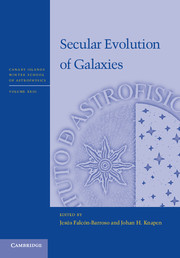Book contents
- Frontmatter
- Contents
- List of contributors
- Participants
- Preface
- Acknowledgments
- Secular evolution in disk galaxies
- Galaxy morphology
- Dynamics of secular evolution
- Bars and secular evolution in disk galaxies: Theoretical input
- Stellar populations
- Star formation rate indicators
- The evolving interstellar medium
- Evolution of star formation and gas
- Cosmological evolution of galaxies
- References
Evolution of star formation and gas
Published online by Cambridge University Press: 05 September 2013
- Frontmatter
- Contents
- List of contributors
- Participants
- Preface
- Acknowledgments
- Secular evolution in disk galaxies
- Galaxy morphology
- Dynamics of secular evolution
- Bars and secular evolution in disk galaxies: Theoretical input
- Stellar populations
- Star formation rate indicators
- The evolving interstellar medium
- Evolution of star formation and gas
- Cosmological evolution of galaxies
- References
Summary
Abstract
In these lectures I review observations of star-forming molecular clouds in our Galaxy and nearby galaxies to develop a physical intuition for understanding star formation in the local and high-redshift Universe. A lot of this material is drawn from early work in the field since much of the work was done two decades ago and this background is not generally available in the present literature. I also attempt to synthesise our well-developed understanding of star formation in low-redshift galaxies with constraints from theory and observations at high redshift to develop an intuitive model for the evolution of galaxy mass and luminosity functions in the early Universe.
The overall goal of this contribution is to provide students with background helpful for analysis of far-infrared (FIR) observations from Herschel and millimetre/submillimetre (mm/submm) imaging with ALMA (the Atacama Large Millimetre/submillimetre Array). These two instruments will revolutionise our understanding of the interstellar medium (ISM) and associated star formation and galaxy evolution, both locally and in the distant Universe. To facilitate interpreting the FIR spectra of Galactic star-forming regions and high-redshift sources, I develop a model for the dust heating and radiative transfer in order to elucidate the observed infrared (IR) emissions. I do this because I am not aware of a similar coherent discussion in the literature.
- Type
- Chapter
- Information
- Secular Evolution of Galaxies , pp. 491 - 554Publisher: Cambridge University PressPrint publication year: 2013
References
- 30
- Cited by

